|
As ESL teachers and educators, we really know how to make our content comprehensible. It's kind of our jam. Comprehensible input is one of the things we've got to master to support our English learners, aka multilingual learners. Text engineering is one way to make our grade-level texts comprehensible so that our ELs, or MLs, can engage right along with other students. That's true equity right there, teacher friends. So what is text engineering? It may be something you are already doing in your classroom, but as with anything in education, using it intentionally is the key! Text engineering is simply amplifying the text, not simplifying it. Aida Walqui and Elsa Billings state in De-Mystifying Complex Texts that when we simplify texts and language within it, it actually makes it more challenging to understand because it takes away the natural linguistic characteristics of the text. Specifically, they say that "with a focus on simplifying the linguistic features of a text, the elements that precisely make writ- ten language comprehensible are taken away. For example, while connectors make a sentence longer, they both alert and clearly establish the meaningful connection between the propositions made within a text. Eliminating these important text features leaves the ELL and ML readers with little syntactic and semantic cohesion to support understanding." What a mindset shift! But can you see it now? Here's a specific example from Fahrenheit 451:
When we remove words such as "now" and "which earlier today", we lose some of the important insinuations that Mildred, Montag's wife, took too many pills on purpose. Also when we simplify, we sometimes add in more unnecessary words to make up for one word. We might use the words "very large" instead of gigantic, for example. So, instead of simplifying, here are some quick tips for amplifying the text by engineering it. It takes no more than ten minutes and is actually kind of fun! I am going to use an example from one of my lesson plans for ELD or ESL class, My Future House Art Origami Lesson Plan, so you can see how I might do it (and PS, there isn't one perfect way! You may do it different than me, especially depending on the students you serve). This lesson plan is one of many in our monthly lesson plan membership for high school ESL teachers, or ELD teachers. You can check out the membership for more monthly resources such as PD for your faculty, guest speakers, checklists, templates, and more! If you'd like to check out a lesson plan to see what they are like, get a free lesson plan here! Chunk the text Chunking the text helps make our grade-level text manageable. It is a great scaffold for our newcomer students, but it is also great for any proficiency level. Just make sure to add more to the chunks as language proficiency grows to make sure you aren't over-scaffolding. Add visuals Possibly the easiest scaffold to help engineer the text is by adding in visuals. I like to add them from online photos into my Google Slides, or use icons from Noun Project. Add a one sentence summary A short, one sentence summary is so powerful! It helps students get the gist to what they will be reading about and it helps them make connections to the new content they will be reading. In the My Future House lesson, the text is the directions for how to fold an origami house. And it's not that easy, let me tell you. I had to watch the video several times to make sure I could follow it! So my one sentence summary at the tops says, "These are directions for folding a house!" I also added in a translation for folding since that is a word they will need to know throughout the directions. Add subheadings I didn't add a subheading in this lesson, but if you have a grade-level text like Fahrenheit 451, it might look like this: Subheading: Montag at the station The Mechanical Hound was gone. Its kennel was empty and the firehouse stood all about in plaster silence and the orange Salamander slept with its kerosene in its belly and the fire throwers crossed upon its flanks and Montag came in through the silence and touched the brass pole and slid up in the dark air, looking back at the deserted kennel, his heart beating, pausing, beating. Faber was a gray moth asleep in his ear, for the moment." (p. 120) Add synonyms or translations Synonyms or translations can be added in parentheses or in the margin next to a word that you can anticipate will be difficult. These are words that you may have identified from a student self-assessment, or maybe they are tier 3 words that are specific to a content area that you know students haven't encountered before. Other things you can take into consideration are if there are multiple meaning words, have affixes, and will show up in other content areas. Read more about academic language strategies for your English learners (and also see some more Fahrenheit 451 examples!). Add audio Audio might be the most time consuming aspect to text engineering, but you definitely don't have to do it every time! You can record audio of you reading the text, or of you reading the summary or subheadings, or even the tricky words and translations if you are bilingual! A great resource for recording audio is Online Voice Recorder. All you have to do is record, hit save, and upload it to your Google Drive, then insert! And finally, let's end on this note: amplifying, not simplifying, the text helps keep our classrooms equitable for our multilingual learners. Every student is getting the same text, but it just looks a little different!
In addition, every student's language output that shows understanding of the text may look different. Even though I am giving my emerging students the same text, it doesn't mean that I want them to do the same thing with it to show me they understand. If students will be writing after they read, maybe my bridging students are writing more extended paragraphs, but my emerging are writing a couple of strong sentences. Maybe my recently arrived, or newcomer students, are using their first language, visuals, or drawings to show me they understand. If there are some favorite ways that you make your content comprehensible for student input and output, let me know in the comments! To continue exploring this topic, check out this podcast episode of Simply Ieva and I chatting about text engineering for ESL students!
1 Comment
Emma Yanez
9/7/2023 01:26:29 pm
I appreciate your example of simplified text and the notion that to simplify does not benefit all learners.
Reply
Leave a Reply. |
AuthorI support middle and high school teachers through monthly lesson plans, coaching, and guest speaker offerings in our Secondary ESL Teacher Membership. Archives
April 2023
Categories
All
|
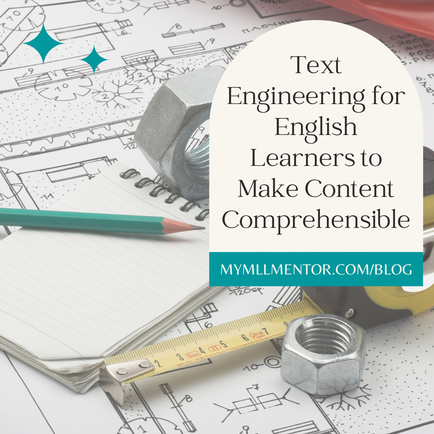
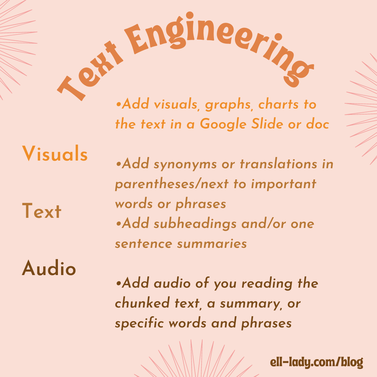
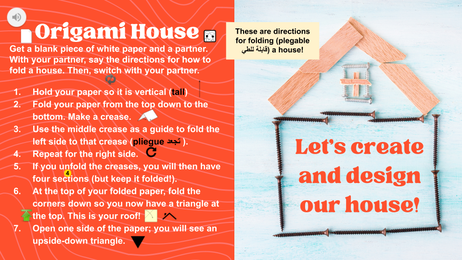
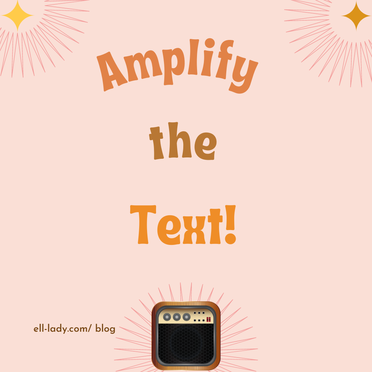
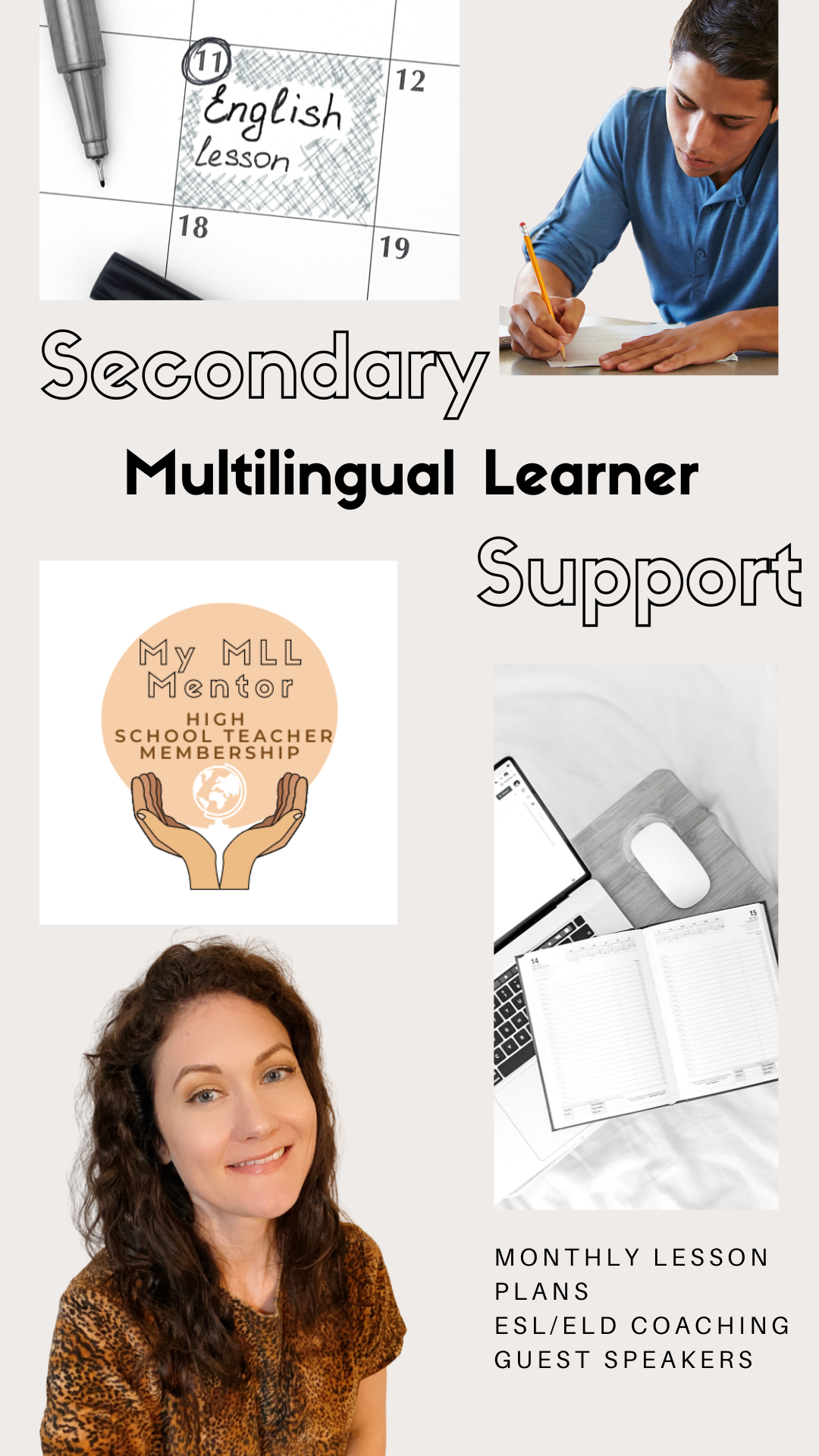
 RSS Feed
RSS Feed
